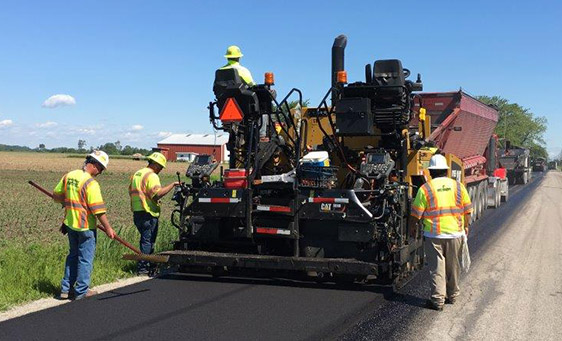Maximize Space Efficiency with Hot Mix Asphalt Angled Parking Lot Solutions
Maximize Space Efficiency with Hot Mix Asphalt Angled Parking Lot Solutions
Blog Article
Unlocking the Tricks of Warm Mix Asphalt Modern Technology
Discovering the depths of hot mix asphalt technology discovers a world where thorough procedures and accurate solutions merge to form our roadways and framework. The fusion of accumulations, binders, and fillers isn't simply a construction job yet a critical orchestration of resilience and effectiveness.
Relevance of Warm Mix Asphalt
Hot Mix Asphalt plays a crucial duty in contemporary framework development as a result of its toughness and cost-effectiveness. As the most typically utilized leading product for roads, freeways, and vehicle parking whole lots, Warm Mix Asphalt uses a variety of benefits that add to its significance in building and construction jobs. One essential advantage is its capability to endure hefty website traffic tons and harsh weather, offering a trustworthy and resilient surface for transportation networks. Furthermore, Warm Mix Asphalt is cost-effective in both initial building and construction and lasting maintenance, making it a favored option for many facilities projects.
The sturdiness of Warm Mix Asphalt stems from its make-up, which consists of aggregates, binder, and filler products that are meticulously chosen and mixed to satisfy specific performance needs. On the whole, the importance of Warm Mix Asphalt in framework development can not be understated, as it continues to be a cornerstone of contemporary building and construction practices.
Elements of Asphalt Mixes
The make-up of asphalt blends is composed of carefully picked accumulations, binder, and filler products that are crucial for attaining specific performance demands. Aggregates are the main part of asphalt mixes, providing stamina and security. The binder, generally asphalt or asphalt concrete, holds the aggregates with each other and offers flexibility and longevity to the mix.
The combination and proportion of these parts play a significant duty in identifying the high quality and performance of the asphalt mix. Engineers carefully create the mix to meet certain needs, thinking about factors like traffic quantity, climate conditions, and sidewalk life expectancy. Correct choice and balancing of aggregates, binder, and fillers are essential for developing long lasting, durable asphalt sidewalks.
Mixing and Production Methods

When the accumulations are picked, the binder, often asphalt cement, is included in bind the products with each other. The binder's high quality and amount substantially affect the mix's strength, adaptability, and resistance to environmental factors. In addition, fillers like hydrated lime or Rose city concrete may be included to boost specific attributes of the asphalt mix, such as its workability or moisture resistance.
Throughout production, the accumulations and binder are heated up, typically in between 250-325 ° F(121-163 ° C ), to help with blending and make sure proper covering of the aggregates. The mixing process should be thorough to attain an uniform mixture that advertises the wanted efficiency characteristics of the asphalt. Various techniques, such as batch blending or drum blending, are utilized to achieve constant and high-quality asphalt blends for construction jobs.
Variables Affecting Asphalt Performance
Aspects influencing asphalt performance encompass a series of variables that influence the sturdiness, durability, and total top quality of asphalt pavements. One key element is the top quality of products used in the asphalt mix. The type and source of aggregates, the binder quality, and the ingredients all play a significant duty in figuring out the efficiency of the asphalt pavement. The gradation of accumulations is important as it impacts the mix's workability, security, and resistance to rutting and cracking.

Design factors to consider, such as sidewalk thickness and drain, are look at these guys essential in guaranteeing the long-term efficiency of the asphalt pavement. By meticulously thinking about these engineers, specialists and factors can optimize asphalt performance and improve the service life of sidewalks.
Sustainable Practices in Asphalt Technology

WMA permits for the production and positioning of asphalt mixes at reduced temperature levels compared to traditional hot-mix asphalt, resulting in reduced power usage and greenhouse gas exhausts. The use of porous asphalt mixes can assist mitigate stormwater runoff problems by enabling water to penetrate via the pavement and right into the ground, promoting natural water filtering and charge procedures.
Conclusion
Finally, warm mix asphalt technology plays an important duty in modern framework development as a result of its durability and cost-effectiveness. By thoroughly stabilizing parts, utilizing proper blending methods, and taking into consideration numerous elements, designers can create high-quality asphalt mixes that withstand rush hour loads and rough weather anchor problems. Accepting sustainable practices, such as making use of warm-mix modern technologies and recycled products, further enhances the environmental friendliness of asphalt modern technology.
Blending and manufacturing techniques in hot mix asphalt technology involve the exact combination and processing of aggregates, binder, and fillers to create a high-performance and resilient asphalt mix.Elements affecting asphalt efficiency include a range of variables that influence the longevity, durability, and general high quality of asphalt sidewalks. Lasting practices in asphalt technology encompass various efforts intended at reducing the environmental impact of asphalt manufacturing and paving processes. By including reclaimed asphalt pavement (RAP) and recycled asphalt shingles (RAS) into new asphalt blends, the industry can substantially minimize the intake of raw products and power, while also lowering garbage dump waste.
WMA enables for the manufacturing and placement of asphalt mixes at lower temperature levels contrasted to typical hot-mix asphalt, resulting in minimized power usage and greenhouse gas discharges.
Report this page